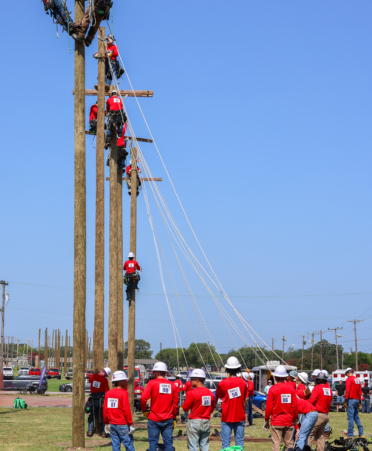(WACO, Texas) – Texas State Technical College is training future workers on how to stay safe and healthy while working in the heat.
According to the U.S. Bureau of Labor Statistics, more than 450 workers died as a result of environmental heat in the United States from 2011 to 2022. There were also more than 33,800 work-related heat injuries and illnesses factoring into days off from work during the same period.
TSTC students in the Occupational Safety and Environmental Compliance program learn how to use a heat stress monitor, which provides a WetBulb Globe Temperature, in the third-semester Industrial Hygiene Applications course. Students also learn about heat illness signs and early treatment in the fifth-semester Safety and Health First Aid Certification course.
“The heat stress monitor takes into account humidity, temperature, and sun load to determine the stress that heat is putting on a worker’s body,” said Mark Wilfert, an instructor in TSTC’s Occupational Safety and Environmental Compliance program.
Acclimatization is important to slowly adapt the body for working in the heat.
“It is common for some entities to administer work/rest cycles to elevate heat stress,” said Curtis Keener, an instructor in TSTC’s Occupational Safety and Environmental Compliance program. “A well-balanced diet and ample amount of rest are additional properties to managing heat stress also.”
Safety workers have resources to look to for guidance on outdoor work and heat. These include the National Weather Service, the National Institute for Occupational Safety and Health, and the Occupational Safety and Health Administration.
Adrian Lampe, a lab assistant in TSTC’s Welding Technology program, also serves as its safety officer. During the summer semester, Lampe arrives on campus before the sun rises and leaves in the midafternoon. Within that time, he ensures that students wear correct personal protective equipment, along with steel-toe boots, gloves, and long-sleeve shirts.
“I make sure all students and instructors stay hydrated and drink plenty of water,” he said.
Lampe also works with instructors to determine what to discuss during Friday safety meetings. He said he types reminders in a program group chat to emphasize problems quicker.
Eric Carithers, director of alignment for TSTC’s statewide Electrical Lineworker and Management Technology program, said students are taught early how to recognize the signs of heat exhaustion and heat stroke since personal protective equipment and rubber gloves can trap heat.
“We do our best to schedule first-semester climbing students in the morning hours,” Carithers said. “Instructors also ease students into full personal protective equipment use on day one, allowing their bodies to adapt without being overwhelmed. Acclimation is treated just like any other jobsite skill: it is taught, practiced and taken seriously.”
Keeping cool for the Lineworker program’s students involves drinking water provided at the campus pole yards, using bandanas or cooling towels, wearing light and breathable base layers, and rotating tasks to avoid overexertion.
“It’s important for them (students) to realize that taking care of your body in this industry is a 24-hour-a-day job,” Carithers said.
Registration continues for the fall semester at TSTC. For more information, go to tstc.edu.
